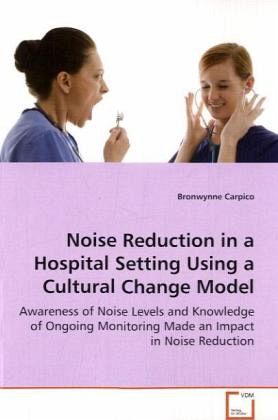
Noise Reduction in a Hospital Setting Using a Cultural Change Model
Awareness of Noise Levels and Knowledge of Ongoing Monitoring Made an Impact in Noise Reduction
Versandkostenfrei!
Versandfertig in 6-10 Tagen
32,99 €
inkl. MwSt.

PAYBACK Punkte
16 °P sammeln!
The World Health Organization reports that whilenormal conversations occur at fifty-six to sixty dB,conversations in hospitals generally occur at higherlevels due to the louder baseline noise fromequipment and hospital activity. They recommend thatnoise levels in patient rooms be maintained at levelsat or below 35 dB. Environmental modifications caneffectively decrease noise levels, yet the process ofcaring for hospitalized patients necessitatesfrequent and ongoing interpersonal dialogues.Minimizing the patient exposure to interpersonalcommunications between employees requires a change inemplo...
The World Health Organization reports that while
normal conversations occur at fifty-six to sixty dB,
conversations in hospitals generally occur at higher
levels due to the louder baseline noise from
equipment and hospital activity. They recommend that
noise levels in patient rooms be maintained at levels
at or below 35 dB. Environmental modifications can
effectively decrease noise levels, yet the process of
caring for hospitalized patients necessitates
frequent and ongoing interpersonal dialogues.
Minimizing the patient exposure to interpersonal
communications between employees requires a change in
employee behaviors. Hospital based studies have
reported some success in reducing noise levels by
establishing equipment and purchase standards related
to noise and designing units to control sounds. While
effective, structural changes and equipment purchases
can be cost prohibitive for many facilities. The goal
of this pilot study was to develop, implement and
evaluate an educational program on noise reduction.
normal conversations occur at fifty-six to sixty dB,
conversations in hospitals generally occur at higher
levels due to the louder baseline noise from
equipment and hospital activity. They recommend that
noise levels in patient rooms be maintained at levels
at or below 35 dB. Environmental modifications can
effectively decrease noise levels, yet the process of
caring for hospitalized patients necessitates
frequent and ongoing interpersonal dialogues.
Minimizing the patient exposure to interpersonal
communications between employees requires a change in
employee behaviors. Hospital based studies have
reported some success in reducing noise levels by
establishing equipment and purchase standards related
to noise and designing units to control sounds. While
effective, structural changes and equipment purchases
can be cost prohibitive for many facilities. The goal
of this pilot study was to develop, implement and
evaluate an educational program on noise reduction.












